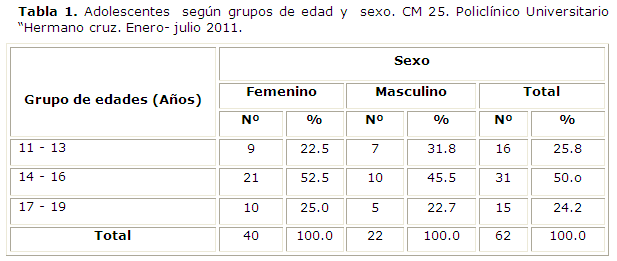Assessment of the Level of Knowledge of Young Adolescents about Sexuality
Keywords:
Health knowledge, attitudes and practice, Sexuality, Adolescent.Abstract
Introduction: adolescence is a time of changes that occur rapidly, affecting the social, cultural, psychological, anatomical and physiological sphere.Objective: a descriptive, longitudinal study was conducted in order to assess the level of knowledge of young adolescents about sexuality at the community doctor´s office # 25.
Material and methods: the universe was composed of adolescents who live in the area of the office and agreed to participate, 119 in total, and the sample was of 62 adolescents who met inclusion and exclusion criteria. The variables contained in the questionnaire were analyzed applied to the results; we applied the statistical method to determine the degree of significance.
Results: most adolescents had more than 14 years of age and were female. They received sexual information for more than 2 ways, followed by friends, parents and teachers. More than half of them have had intercourse, highlighting the group of 16-19 years, and 15 years, and a lot of teens reported first sexual intercourse. The best known contraceptive was the condom; the majority of them had contraceptive sexual intercourse.
Conclusions: knowledge related to sexuality and teenage pregnancy through the implementation of the educational intervention increased and thus they were preparing for a healthy and responsible sexuality.
Downloads
References
1. Muñoz A, Zamarreño W. Comportamiento del embarazo en la adolescencia en 87 pacientes. Rev 16 de abril. [Internet] 2006 [Citado 20 de junio de 2011]; 223: [Aprox. 13p.]. Disponible en: http://www.16deabril.sld.cu/rev/223/articulo2.html
2. Sibai BM. Intergenerational Factors : A Missing Link for Preeclampsia, Fetal Growth Restriction. Hypertension, Journal of American Heart Association. [Internet] 2008;51:993-994 doi: 10.1161/HYPERTENSIONAHA.107.104489 [Citado 20 de junio de 2011]; [Aprox. 3p.]. Disponible en: http://www.ncbi.nlm.nih.gov/pubmed/17261123
3. Rodríguez PL, Hernández J, Reyes A. Bajo peso al nacer. Algunos factores asociados a la madre. Rev. Cubana Obstet Gynecol. [Internet] 2006 [Citado 20 de junio de 2011]; 32(3). Disponible en: http://scielo.sld.cu/scielo.php?script=sci_arttext&pid=S0138-600X2006000300001
4. Cedergren MI. Optimal gestational weight gain for body mass index categories. Obstet Gynecol. [Internet] 2007 [Citado 20 de junio de 2011]; 110(4): [Aprox. 5p.]. Disponible en: http://journals.lww.com/greenjournal/Fulltext/2007/10000/Optimal_Gestational_Weight_Gain_for_Body_Mass.6.aspx
5. Rodríguez Cabrera A, Álvarez Vázquez L. Percepciones y comportamientos de riesgo en la vida sexual y reproductiva de los adolescentes. Rev. Cubana Salud Pública. [Internet] Ene-mar 2006 [Citado 20 de junio de 2011]; 32 (1): [Aprox. 10p.]. Disponible en http://www.bvs.sld.cu/revistas/spu/vol32_1_06/spu08106.pdf
6. González T, Tapia CJ, Aguirre M. Caracterización de asistentes a consejería en sexualidad en un centro de salud integral de adolescentes. Rev. Chil. Pediatr. [Internet] 2005 [Citado 20 de junio de 2011]; 76 (6): [Aprox. 6p.]. Disponible en: http://www.scielo.cl/scielo.php?pid=S0370-41062005000600004&script=sci_arttext
7. Manual Merck. Aproximación a la asistencia de los adolescentes. Sección 19. En: El Manual Merck de diagnóstico y tratamiento. 11 edición. Editorial Elsevier; 2007.p. 2475.
8. García Roche R, Cortés Alfaro A, Vila Aguilera LE, Hernández Sánchez M, Mesquía Valera A. Comportamiento sexual y uso del preservativo en adolescentes y jóvenes de un área de salud. Rev. Cubana Med Gen Integr. [Internet] 2006 [Citado 20 de junio de 2011]; 22 (1): [Aprox. 9p.]. Disponible en: http://bvs.sld.cu/revistas/mgi/vol22_1_06/mgi03106.htm
9. Ministerio de Salud Pública. Anuario Estadístico 2007. Datos Demográficos. Ciudad Habana: MINSAP; 2007.
10. Mathews MS, MacDorman MF. Mortality Statistics from the 2005 Period Linked Birth/Infant Death Data Set. National Vital Statistics Reports. [Internet] 2008 [Citado 20 de junio de 2011]; 57(2): [Aprox. 32p.]. Disponible en: http://198.246.98.21/nchs/data/nvsr/nvsr57/nvsr57_02.pdf
11. American College of Obstetricians and Gynecologists (ACOG). Especially for Teens: Having a Baby. Patient Education Pamphlet; August 2007.
12. Leiva Marín Y, Artiles de León I, Flórez M, Cano López AM, Bravo Fernández O, Castro Espín M, et al. Salud Sexual, Sexualidad y Trastornos Sexuales. En: Álvarez Sintes R. Temas de Medicina General Integral. 2da ed. La Habana: Ecimed; 2008. p.100-11.
13. Álvarez Sintes R. Temas Medicina General Integral. Anticoncepción en las adolescentes. La Habana: Editorial Ciencias Médicas; 2008.
14. Kathleen Henry S. Más uso de anticoncepción menos aborto. Rev Network en Español. 2002; 21(4): 28-33

Published
How to Cite
Issue
Section
License
Authors who have publications with this journal agree to the following terms: Authors will retain their copyrights and grant the journal the right of first publication of their work, which will be publication of their work, which will be simultaneously subject to the Creative Commons Attribution License (CC-BY-NC 4.0) that allows third parties to share the work as long as its author and first publication in this journal are indicated.
Authors may adopt other non-exclusive license agreements for distribution of the published version of the work (e.g.: deposit it in an institutional telematic archive or publish it in a volume). Likewise, and according to the recommendations of the Medical Sciences Editorial (ECIMED), authors must declare in each article their contribution according to the CRediT taxonomy (contributor roles). This taxonomy includes 14 roles, which can be used to represent the tasks typically performed by contributors in scientific academic production. It should be consulted in monograph) whenever initial publication in this journal is indicated. Authors are allowed and encouraged to disseminate their work through the Internet (e.g., in institutional telematic archives or on their web page) before and during the submission process, which may produce interesting exchanges and increase citations of the published work. (See The effect of open access). https://casrai.org/credit/


